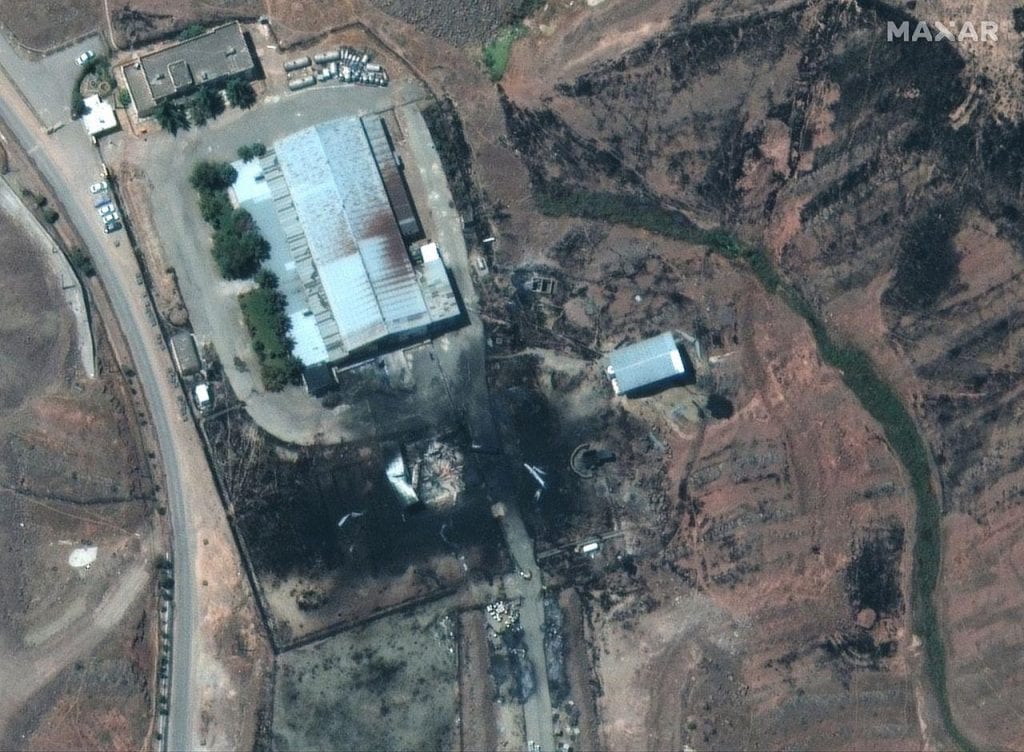
Over the last two weeks, explosions have taken place at the Khojir missile production complex in Tehran and the Natanz nuclear complex. While Iranian officials have downplayed the events, it is likely that both blasts at the facilities were acts of sabotage.
In the morning hours of June 26, Iranian social media users reported a bright light emanating from east Tehran followed by the sound of an explosion.
Iran’s Fars News Agency blamed the explosion on an “industrial gas tank” and the event “had nothing to do with the military installations in the area.”
However, the information published by Fars News was not accurate. Analysis of commercial satellite imagery confirmed the explosion took place inside the Khojir missile production complex. The site is located near the Parchin military base which has been subjected to United Nations scrutiny for suspected weapons-grade nuclear activity.
Following the explosion, local media was allowed access to the site of the blast to film what remained of the industrial gas tanks that were destroyed in the incident.
Less than a week later, an explosion at the Natanz nuclear complex was reported in the morning hours of July 2.
“A building within the Iranian Natanz nuclear complex was damaged after a fire on Thursday morning with no casualties,” the semi-official news agency Tasnim said.
The Atomic Energy Organization of Iran, which is the main government agency responsible for operating nuclear energy in Iran, minimized the event saying the fire affected an under-construction “industrial shed.”
Adding to what may have caused the fire at Natanz, The New York Times reported the incident was a deliberate act of sabotage.
“The blast was caused by an explosive device planted inside the facility. The explosion, he [anonymous intelligence official] said, destroyed much of the aboveground parts of the facility where new centrifuges — delicate devices that spin at supersonic speeds — are balanced before they are put into operation,” The New York Times reported.
In a follow-up of the report, Israel was identified as being responsible for the incident at Natanz.
“A Middle Eastern intelligence official with knowledge of the episode said Israel was responsible for the attack on the Natanz nuclear complex on Thursday, using a powerful bomb. A member of the Islamic Revolutionary Guards Corps who was briefed on the matter also said an explosive was used,” according to The New York Times.
Furthermore, an opposition group calling itself “Homeland Cheetahs” sent a statement to several BBC Persian journalists claiming responsibility for the fire. The group stated they were an “underground opposition within Iran’s security apparatus.”
Overhead commercial satellite imagery taken of Natanz before and after the incident revealed the extent of the damage caused by the fire.
According to a Reuters report, an Iranian official threatened Iran would retaliate if it concluded that the incident was a cyber attack, suggesting the incident may have not been caused by an explosive device planted at the facility as reported by The New York Times.
“Responding to cyber attacks is part of the country’s defense might. If it is proven that our country has been targeted by a cyber attack, we will respond,” civil defense chief Gholamreza Jalali told state TV late on Thursday.
Adding to the significance of the site in question, the Reuters report quoted a second Iranian official who stated the structure that caught fire was a centrifuge assembly building.
“One of the officials said the attack had targeted a centrifuge assembly building, referring to the delicate cylindrical machines that enrich uranium, and said Iran’s enemies had carried out similar acts in the past.”
The incidents that have occurred at two Iranian military sites involving its nuclear and missile programs — all within a week’s period — raises the chance that the events were caused by acts of sabotage.
The possible attacks are reminiscent of operation “Olympic Games” which was a joint operation of the CIA and Mossad. The operation used cyber warfare to disrupt the centrifuges that were enriching uranium for Iran’s nuclear weapons program.
Additionally, the previously unknown group “Homeland Cheetahs” is likely a front for an unknown actor that may be attempting to create plausible deniability and distance itself from the attack.
If Israel is behind the attacks, it will be another act of sabotage added to a long list of operations carried out against Iran’s nuclear weapons program. A response by Iran is anticipated, whether it’s through cyber warfare or military action remain to be seen.







